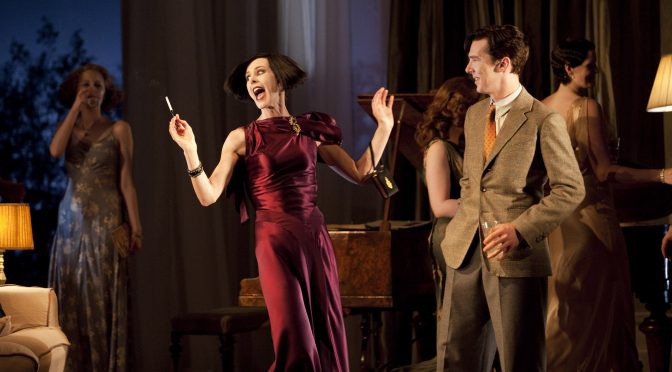The National Theatre’s contribution to the Terence Rattigan centenary celebrations is one of his least known plays, After the Dance. This provides a provocative insight into the Bright Young Things – that post-WWI, Bohemian generation – and in particular what happens to them in later life. Set in 1938, the play’s serious-minded youngsters observe their elders with disdain. This new generation thinks the party should have ended long ago and, with a new war looming, it becomes clear that any dance now is likely to be a macabre one.
The Scott-Fowlers are a wealthy and glamorous couple, still on the party scene and seemingly enjoying themselves. Reaching for the gin with improbable frequency, even more impossibly they retain their wit. They may not be young but they are still bright and a great source of comedy. Benedict Cumberbatch and Nancy Carroll portray this sophistication perfectly – they positively sparkle.
The Scott-Fowlers are joined by their ‘court jester’ John Reid, played by National Theatre stalwart Adrian Scarborough, who (as usual) manages to steal any scene he is in. We also get to meet their friends, including a cameo from Pandora Colin that is worth the price of a ticket alone. Her character’s vague distaste of her Bloomsbury days now that times have moved on is not only hilarious but reveals the dichotomy this group lives with – obsessed with the past, they are also slaves to fashion.

Aloof to it all, David Scott-Fowler’s cousin and young secretary, Peter, is played superbly by the always impressive John Heffernan. While intrigued with the glamorous life he isn’t ashamed of being the “bore” his elders live in fear of being described as. His fiancée Helen also sees that the pretence of being continually interesting is exhausting, but is in love with the older David and young enough to try to change him. Faye Castelow gives this pursuit an almost sinister edge and shows how Helen fails to recognise the depth of character she lectures about is actually already present. Given the chance to show their characters’ deeper side, Cumberbatch and Carroll excel once again.
There is no doubt that this is a revival to cherish. Rattigan’s masterfully crafted script is directed with characteristic clarity by Thea Sharrock. The production values are as high as we might expect from the National Theatre, with a stylish set from Hildegard Bechtler and breathtaking costumes. Any reference to contemporary events and the economic boom of recent history are (perhaps thankfully) avoided. Entertaining and interesting, impeccably performed and produced, this is the perfect period piece.
Until 11 August 2010
Photo by Johan Persson
Written 9 June 2010 for The London Magazine

